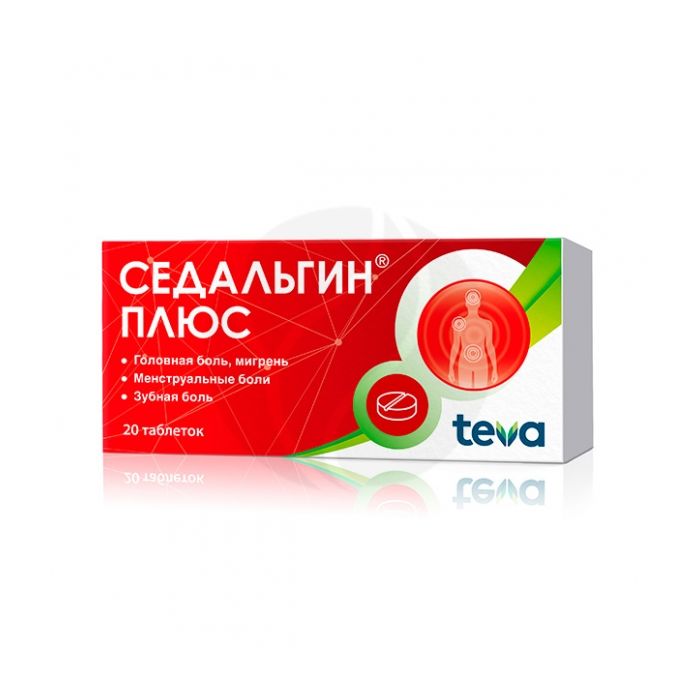Sedalgin plus tablets, No. 20
Expiration Date: 11/2025
Russian Pharmacy name:
Седальгин плюс таблетки, №20
Moderate or mild pain syndrome, of various origins: headache (including migraine), toothache, neuralgia, muscle pain (myalgia), joint pain (arthralgia), radicular syndrome, menstrual pain (algomenorrhea).
Feverish syndrome with 'colds' and other infectious and inflammatory diseases (with an established diagnosis).
Inside, after meals, 1 tablet 2-3 times in the morning. The maximum single dose for adults and adolescents from 16 years old is 2 tablets, the maximum daily dose is 6 tablets for no more than 1-2 days.
Children aged 12 to 16 years - half or one tablet 2-3 times a day, the maximum daily dose is 4 tablets.
Duration of admission - no more than 5 days when prescribed as an anesthetic and 3 days as an antipyretic agent.
If symptoms persist or worsen, you should see your doctor.
An increase in the daily dose of the drug or the duration of treatment is possible only under the supervision of a physician.
1 tablet contains:
active ingredients: metamizole sodium - 500 mg, caffeine - 50 mg, thiamine hydrochloride - 38, 75 mg;
excipients: microcrystalline cellulose 45.75 mg, wheat starch 11.00 mg, gelatin 4.00 mg, colloidal silicon dioxide 2.50 mg, talc 12.00 mg, magnesium stearate 6.00 mg.
Hypersensitivity to drug components;
Hypersensitivity to other pyrazolone derivatives - phenylbutazone;
Severe hepatic and / or renal impairment;
Bronchospasm;
Deficiency of glucose-6-phosphate dehydrogenase (syndrome of congenital deficiency of the enzyme glucose-6-phosphate dehydrogenase);
Diseases of the blood system;
Insomnia;
Uncontrolled arterial hypertension;
Severe atherosclerosis;
Increased intraocular pressure;
Pregnancy and the period of breastfeeding;
Children's age (up to 12 years old).
Pharmacological properties:
Pharmacodynamics:
The combined preparation has analgesic, antipyretic and anti-inflammatory effects.
Metamizole sodium is a pyrazolone derivative and has an analgesic, antipyretic and weak anti-inflammatory effect, the mechanism of which is associated with inhibition of prostaglandin synthesis by inhibiting cyclooxygenase.
Caffeine - has a stimulating effect on the central nervous system (CNS), mainly on the cerebral cortex, respiratory and vasomotor centers.
Increases mental and physical performance, reduces drowsiness, fatigue.
Caffeine increases the permeability of histohematogenous barriers and increases the bioavailability of non-narcotic analgesics, thereby enhancing the therapeutic effect.
Thiamin (vitamin B1) is involved in metabolism and improves neuro-reflex conduction.
Pharmacokinetics:
The pharmacokinetic properties of SedalginЃ Plus depend on the pharmacokinetics of its components.
Metamizole sodium
Metamizole sodium is absorbed quickly and completely in the gastrointestinal tract, reaching a maximum plasma concentration on average 60-90 minutes after administration.
It binds to plasma proteins and is metabolized in the liver.
Along the way of non-enzymatic hydrolysis, it is cleaved to 4-methylaminoantipyrine with further metabolism through active 4-aminoantipyrine to 4-acetylaminoantipyrine - the main metabolite, 90% of which is excreted through the kidneys and 10% - with bile with a half-life of about 10 hours.
Caffeine
Caffeine, which is part of the drug, is almost completely absorbed, the maximum concentration in the blood plasma is determined after 30-40 minutes.
It quickly passes through the blood-brain and placental barriers, enters breast milk, and is excreted (including in the form of metabolites) mainly by the kidneys.
Thiamine
Absorption is high, throughout the small intestine.
Before absorption of thiamine, hydrochloride is released from the bound state by digestive enzymes.
In the blood, the concentration of thiamine hydrochloride is relatively low.
In plasma, free thiamine is found mainly, in erythrocytes and leukocytes - its phosphorus esters.
Half of the total is contained in striated muscles (including the myocardium) and about 40% in internal organs. Phosphorylation occurs in the liver.
The most active phosphoric ester is thiamine diphosphate, which has coenzyme activity.
It accumulates mainly in the liver, heart, brain, kidneys, spleen.
It is excreted through the intestines and kidneys.
Side effect:
From the gastrointestinal tract: loss of appetite, nausea, vomiting, cholestasis, jaundice;
From the side of hematopoiesis: thrombocytopenia, leukopenia, agranulocytosis, hemolytic anemia, purpura;
From the side of the central nervous system: insomnia, dizziness, increased excitability;
From the side of the cardiovascular system: palpitations, heart rhythm disturbances;
Allergic reactions: skin rash, itching, redness, Quincke's edema, anaphylactic shock; bronchospasm.
All side effects should be reported to your doctor.
Overdose
Symptoms: nausea and vomiting sometimes with blood, pain in the stomach, mental and motor agitation, tachycardia, heart rhythm disturbances, possibly a decrease or increase in urine output, convulsions, anxiety, confusion, delirium, dehydration, hyperthermia, headache, increased tactile or pain sensitivity, tremors, or muscle twitching; ringing in the ears, epileptic seizures (in acute overdose - tonic-clonic).
Treatment: you should immediately seek medical attention. The victim should undergo gastric lavage, prescribe adsorbents (for example, activated carbon), laxatives drugs. If necessary, symptomatic treatment is carried out (for hemorrhagic gastritis - administration of antacid drugs and gastric lavage with ice-cold 0.9% sodium chloride solution; maintenance of ventilation and oxygenation; with epileptic seizures - intravenous diazepam, phenobarbital or phenytoin; maintenance of fluid and salt balance).
Interaction with other medicinal products
The simultaneous use of metamizole sodium (analgin) with other non-narcotic analgesics, non-steroidal anti-inflammatory drugs can lead to a mutual increase in toxic effects.
Tricyclic antidepressants, oral contraceptives, allopurinol disrupt the metabolism of metamizole sodium in the liver and increase its toxicity.
Barbiturates, phenylbutazone (butadione) and other inducers of microsomal liver enzymes weaken the effect of sodium metamizole. The simultaneous use of metamizole sodium with cyclosporine reduces the concentration of the latter in the blood.
Sedatives and tranquilizers enhance the analgesic effect of metamizole sodium.
special instructions
Excessive consumption of caffeine-containing products (tea, coffee) during treatment can cause overdose symptoms.
It is used with caution and under medical supervision in patients with impaired liver or kidney function.
The simultaneous use of the drug with alcoholic beverages is not recommended.
In patients with atopic bronchial asthma, hay fever, there is an increased risk of developing hypersensitivity reactions.
Influence on the ability to drive vehicles and work with mechanisms
Care must be taken when driving vehicles and working with mechanisms that require increased concentration of attention and speed of psychomotor reactions, since dizziness may develop when taking the drug.

